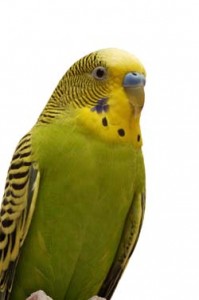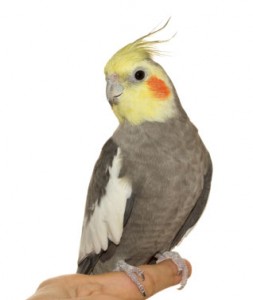Two small companion parrots have consistently been the most popular ones in the United States. For years, budgies, also called parakeets, were the most numerous companion birds, and only recently were overtaken by cockatiels. If you’re looking at getting one or the other, how do they compare?
Similarities
Cockatiels and budgies are both parrots, or hookbills, with hooked beaks suitable for cracking seed. Both live in flocks in the wild and lay eggs in holes in trees, which is also a trait shared by many parrots. Budgies and cockatiels are natives of arid, inland Australia. These are common species in their native Australia, and they are quite numerous in aviculture.
Both cockatiels and budgies are desert-adapted birds. I’m convinced that some of their success as companion and aviary birds is due to the fact that they can survive under less than ideal situations. They thrive when fed a formulated diet and vegetable treats, with fresh water and loving socialization. But they have survived all-seed diets and unsuitable environments — and sadly, even neglect.
Both cockatiels and budgies became companion birds through the efforts of John Gould in the 19th century. He brought these two species to England and Europe, where they started to become established in wildlife collections. Because of this relatively long history in captivity, color mutations have developed in both species.
Cockatiels in the wild are solid gray with red cheek patches and white wing patches. In captivity, cockatiels can have lacy or pied patterns and a range of colors, from soft brown to gray, cream and white. Wild budgies are green with yellow faces, but those kept as pets come in many colors of the rainbow. Common pet budgie coloring is a green bird with a yellow face or a blue bird with a white face. Their bodies also can be patterned or pied, and their colors are myriad and varied.
 All of the cockatiels, no matter what color, are not different breeds but only different colors of one species. The same goes for budgies, which are all still budgies. They simply come in a variety of colors (and sizes and shapes, we’ll get to that).
All of the cockatiels, no matter what color, are not different breeds but only different colors of one species. The same goes for budgies, which are all still budgies. They simply come in a variety of colors (and sizes and shapes, we’ll get to that).
We keep both species as pets because cockatiels and budgies are easily hand tamed. They are both curious enough to also learn other behaviors and tricks, if their owner cares to work with them. Budgies have often been thought of as pets for children, but they can be interesting companions for adults and seniors as well. The same goes for cockatiels. They make good, interactive adult companions and can help keep a senior company without the need for walks and without being underfoot with its potential for causing a fall.
In both cockatiels and budgies, it is the male that typically learns to talk, while the females generally do not. Both species adapt well to living in most home situations. You can offer them a roomy cage and a chance to fly free in the average home and apartment, which cannot be said of some larger parrot species!
Since I mentioned apartments, both cockatiels and budgies make good apartment pets. They do vocalize, but generally their calls do not disturb neighbors. And, like most parrots, they are quiet all night, which makes them good neighbors, too.
Differences
Birds have individual personalities but, in general, cockatiels are low energy and pacifists. They spend a lot of time sitting and preening. Cockatiels are most likely to vocalize in mornings and evenings; cockatiels are the smallest member of the cockatoo family and act like one of them. Budgies move around and play a lot, as well as keep up a steady chatter while they do so. Budgies are parakeets, a group of long tailed, slim-bodied birds found throughout the world. You may know of Indian ring-necked parakeets, the Carolina parakeet (which became extinct in the U.S.) and the South American native, the quaker parakeet, for example.
There is definitely a difference in size between these two species. A cockatiel is generally 12 to 14 inches from the top of its head to the end of its tail feathers. Budgies vary in size from 5 to 11 inches. Why is there such a big difference in budgie size? The budgies most often raised as pets are called “American parakeets” and are about 5 to 6 inches long. Budgies bred by exhibitors to be larger are called “English budgies” and are 10 to 12 inches long. The biggest English budgies and the smallest cockatiels are similar in size. Despite the size difference, American parakeets and English budgies have the same DNA, the show birds have just been selectively bred to be bigger and to have a certain conformation.
Which Bird Is Right For You?
You may have a preference for a budgie or a cockatiel because of their size. Budgies are smaller, and so their cage could be slightly smaller than suitable for a cockatiel environment. Which bird would you rather handle? And how do you propose to handle your bird? Budgies are very trainable and can become hand tame. If you want a bird to interact with vocally and to fly after you in the house, the budgie is a good choice. A budgie is not, however, as tolerant of petting as a cockatiel can be.
Many cockatiels love to be petted behind their crest feathers and over their ears (marked in many colors by that fiery red cheek patch). A budgie typically does not like this type of interaction. Choose the bird to match your personality: cockatiels are low key and touchy feely, while budgies are high energy and will perch on a finger but generally don’t like to be touched.
Size in companion birds correlates with age span. A budgie can live 10 to 15 years, while a cockatiel can live 15 to 20-plus years. Obviously, accidents may happen or a bird could get a disease that shortens its life. By the same token, each species can outlive their projected lifespan.
Both species make rewarding, interesting and loving companion birds. That’s something else they have in common!






I’ve had several cockatiels and a few budgies. For the most part, the cockatiels seemed to be easier to get along with, but I had one male who got into mating mode and fell in love with another male and decided I was competition. He actually went from sweet an loving to flying at my face and trying to bite me every time I came into the room!
I agree with Carolyn, a cockatiel in mating mode can be quite aggressive. Overall, I find cockatiels more hand tame than budgies, but unlike the author, I certainly do not find them to be passive. Mine are confident, strong flyers, territorial, messy, noisy and curious. They love to be with other cockatiels, and are very cute to watch in a group hanging out on the floor. My budgies tend to be more shy with people, love to have a bird mate of their own, and like to fly freely in and out of their cages. The budgies chatter is softer than the cockatiels.
The female budgies are more dominant than the males.
I have a large indoor apt cage, that houses 4 Zebra finches. If I added two budgies, would they all get along? Will this be a big problem? Thanking you in advance for your speedy reply………Russ
P.S. Thanks so much for your very good article on Cockatiels and Budgies.
This reply is from the author of the article, Diane Grindol:
They can get along, but… will every one eat the same food? Will you be breeding in the aviary? That’s when there could be the most contention between birds.
You’ll have the best chance of success if the aviary is spacious and each species can get away from the other when it needs to. I would be inclined to hang the budgies in a cage inside the aviary first to see how they and the finches react. Then move to opening the cage door, then to moving the cage. Be sure there are plenty of food and water dishes so no one guards them from others.
I have a male cockatiel named Buddy. He is very loving and he loves to sit with me and do chores with me. He has a playgym upstairs and he loves to keep my 17 year old cat Tabby company. At lunch time, he likes some crunchy peanut butter and some cheerios, also he likes to sample what I am eating. He is ten years old now and I can’t imagine life without him!!
We breed and show cockatiels along with breeding parakeets. It was brought to our attention by our vet that we should limit the Cheerios ( which our breeders love ) due to the Zinc content which is not good for them and can cause problems with babies.
“Angel” my 10 year old cockateil has been with me since he was about 3 months old.
I was able to hold him, cuddle him, nuzzle him and interact on many levels.
He talks and is attentive and free flying at will. All in all he is a delightful pet.
HOWEVER…. when he was about a year or so old, he began biting my hand
or fingers. I have no explanation except perhaps that with the onset of
maturity that part of his personality changed. He still nuzzles my face and neck
as long as I don’t go near with fingers. WHY? Is it possible to break
this bad trait?